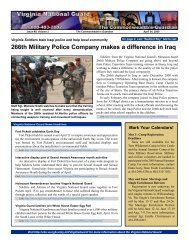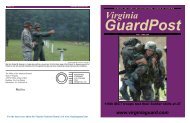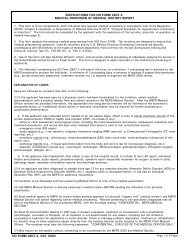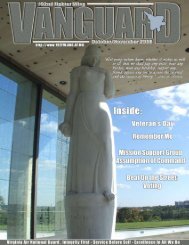GuardPost
Virginia - the Virginia National Guard homepage! - U.S. Army
Virginia - the Virginia National Guard homepage! - U.S. Army
- No tags were found...
Create successful ePaper yourself
Turn your PDF publications into a flip-book with our unique Google optimized e-Paper software.
PAGE 6<br />
116th BCT gets familiar with new<br />
equipment at annual training<br />
By Sgt. 1st Class A.J. Coyne<br />
Virginia Guard Public Affairs<br />
When the Soldiers of the 116th Brigade<br />
Combat Team conducted annual training<br />
at Fort Pickett in June, they trained on<br />
and prepared to field more than a dozen<br />
new systems designed to increase their<br />
efficiency and effectiveness both in and<br />
out of combat.<br />
“We’re fielding new weapons, equipment<br />
and command and control systems,”<br />
said Lt. Col. Allan Carter, director of<br />
operations, plans and training for the 116th<br />
Brigade Combat Team. “We’ve received<br />
the latest, most sophisticated versions of<br />
Army equipment.”<br />
The 116th Brigade Combat Team was<br />
chosen to receive the new systems as part<br />
of the Army Chief of Staff’s Executive<br />
Order. According to an Army News story,<br />
the Army reset program is one of Gen.<br />
George W. Casey Jr.’s four imperatives,<br />
and it costs an average of $16 billion to<br />
reset more than 20 brigades each year.<br />
The program, which began more<br />
than three years ago, is responsible for<br />
recapitalizing or replacing more than<br />
300,000 pieces of equipment.<br />
The program applies to both active<br />
duty and reserve component units. One<br />
of its goals is to get new equipment to<br />
Soldiers within six months of a unit’s<br />
return, that way they’ll have plenty of<br />
time to familiarize themselves with the<br />
equipment and train on it before beginning<br />
another deployment.<br />
Among the new equipment the brigade<br />
received are vehicles, weapons and<br />
communication systems.<br />
Among the new vehicles the 116th is<br />
fielding are four M1200 Armored Knights,<br />
wheeled, armored vehicles that carry the<br />
equipment needed to quickly bring in<br />
guided bombs, missiles and shells.<br />
The brigade also increased its haul and<br />
lift capability thanks to a large quantity<br />
of medium tactical vehicles, according to<br />
Carter.<br />
Because of recent deployments overseas,<br />
many Soldiers throughout the brigade are<br />
familiar with many of the Army’s newest<br />
command and control systems, which are<br />
already in use in combat zones. But now<br />
they are getting reacquainted with the<br />
systems as their units are fielding them<br />
here.<br />
The 116th BCT is now fielding a<br />
number of components for the Army Battle<br />
Command System, a digital command,<br />
Photo by Spc. J. Erin Jones, 116th Brigade Combat Team Public Affairs<br />
A Soldier from the 116th Brigade Combat Team trains on a Javelin anti-tank missile.<br />
A shoulder- fired weapon, the Javelin has a range of more than 2,500 meters.<br />
VIRGINIA NATIONAL GUARD<br />
Photo by Sgt. 1st Class A.J. Coyne, Va. Guard PAO<br />
Spc. Al Bowker, a Soldier with Company<br />
A, Brigade Special Troops Battalion,<br />
116th Brigade Combat Team, trains on a<br />
new Handheld Standoff Mine Detection<br />
System during annual training.<br />
control, communications, computers and<br />
intelligence system for the battlefield<br />
Army.<br />
But the new systems aren’t just important<br />
in a combat situation. New water purifying<br />
systems received by Company A, 429th<br />
Brigade Support Battalion could be used<br />
in a domestic capacity should a natural<br />
disaster require the Guard to provide<br />
potable water to Virginia residents.<br />
In addition to providing information on<br />
the battlefield, both Ravens and Shadows,<br />
two new unmanned aerial vehicle systems<br />
the 116th BCT is now fielding, can also be<br />
used to provide information from the air<br />
in the event of a hurricane or other natural<br />
disaster.<br />
“All of this equipment is federally<br />
funded but we can already see how it can<br />
help us perform our state mission too,”<br />
Carter said.<br />
The majority of the new equipment<br />
arrived in time for annual training,<br />
according to Carter. But some command<br />
and control systems won’t arrive until later<br />
in the year.<br />
The 116th is scheduled to completely<br />
finish fielding the new systems by March<br />
2010.<br />
THE COMMONWEALTH’S GUARDIAN PAGE 15<br />
Virginia Guard conducts hurricane preparedness exercise<br />
By Maj. Cotton Puryear<br />
Virginia Guard Public Affairs<br />
The Virginia National Guard conducted a four-day hurricane<br />
preparedness exercise June 15 - 18 at the State Military Reservation<br />
in Virginia Beach with the goal of improving the Virginia Guard’s<br />
ability to plan and carry out domestic operations in conjunction<br />
with state agencies and local first responders. This particular<br />
exercise simulated a major hurricane hitting the Hampton Roads<br />
area.<br />
“The world has changed since 9-11 and Hurricane Katrina,<br />
and our citizens expect the National Guard to be ready to respond<br />
in a time of crisis,” said Maj. Gen. Robert B. Newman, Jr., the<br />
Adjutant General of Virginia. “The only way we can be properly<br />
prepared to respond in a time of need is to plan, train and exercise<br />
our procedures in coordination with our state partner agencies.<br />
This exercise is an important part of that preparation.”<br />
Approximately 500 Soldiers, Airmen and members of the<br />
Virginia Defense Force took part in the exercise.<br />
In an incident response situation, 91st Troop Command<br />
becomes Joint Task Force 91 and provides command and control<br />
for Virginia Guard units taking part in the mission.<br />
The Fort Pickett-based 183rd Regional Training Institute also<br />
took part in the exercise and worked on expanding the Joint<br />
Reception, Staging, Onward Movement and Integration plan to<br />
bring in units from other states during an emergency.<br />
“The Joint Staff and JTF-91 are the primary training audiences,<br />
but I want this exercise to include the participation, notional or live,<br />
of all necessary elements of the Joint Staff in a way that replicates<br />
emergency conditions as accurately as possible,” Newman said<br />
at the start of the exercise. “The focus of the staff will be on<br />
operations and the integration of different staff elements as well<br />
as the Virginia Defense Force. We hope to identify equipment,<br />
personnel and operational shortfalls related to interaction with<br />
joint and interagency organizations so we are better prepared to<br />
respond to the real thing.”<br />
“Even though this training scenario is based on a hurricane<br />
Photo by Maj. Cotton Puryear, Virginia Guard Public Affairs<br />
Soldiers assigned to the Virginia National Guard review<br />
simulated requests for assistance being funneled into the<br />
Virginia Guard’s Joint Operations Center.<br />
response, the lessons we learn here would apply to any kind<br />
of mission we might receive,” said Col. Rob McMillin, joint<br />
operations officer for the Virginia Guard.<br />
The exercise tested the procedures the Guard uses to respond<br />
to requests for assistance that are funneled through the Virginia<br />
Department of Emergency Management into the Virginia Guard’s<br />
Joint Operations Center.<br />
Representatives from VDEM as well as the Virginia State<br />
Police were involved with the exercise along with other key<br />
agencies like the Virginia Department of Transportation are being<br />
simulated by the exercise control agency.<br />
McMillin said that in a hurricane response situation the Guard<br />
would be prepared to execute a number of preplanned missions<br />
such as assisting the Virginia State Police if the Governor of<br />
Virginia authorized lane reversal for Interstate 64 to evacuate<br />
citizens from the Hampton Roads area and assist in the operation<br />
of the shelters for those citizens once they were evacuated. The<br />
Guard has also planned to conduct security operations to help<br />
the State Police secure areas damaged by the storm, and Virginia<br />
Guard personnel could also assist with debris removal and road<br />
clearance.<br />
For JTF-91, this was the first time the organization was able<br />
to work together as a combined staff. As 91st Troop Command,<br />
the headquarters provides command and control for a number of<br />
different units throughout Virginia, but providing command and<br />
control for a large-scale incident response is a new mission.<br />
“The exercise has gone very well for us,” said Col. Steve Scott,<br />
commander of JTF-91. “Since we have never worked together<br />
in this type of organization, there were a number of things for<br />
us to learn. While we still have areas we need to work on, after<br />
this exercise I am confident we could execute this mission if we<br />
needed to.”<br />
Not all of the staff positions needed for the JTF-91 position<br />
exist in the 91st Troop Command organization, so the unit<br />
integrated members of the Virginia Defense Force into staff<br />
positions like chaplain, communications officer, medical officer<br />
and incident awareness officer.<br />
“The Virginia Defense Force has been invaluable,” Scott said.<br />
“They bring a wealth of experience with them, along with great<br />
enthusiasm and energy for the mission.”<br />
In a large-scale incident response, National Guard units from<br />
other states could be brought in to assist with recovery operations<br />
or other missions.<br />
The 183rd RTI started the exercise with an operations plan for<br />
the JRSOI mission, and they were able to revise that plan based<br />
on lessons learned as the exercise progress, said Lt. Col. Colt<br />
Puryear, operations officer for the 183rd RTI.<br />
“When a unit arrives in Virginia, we need to immediately<br />
provide assistance to fix, feed and fuel them in order to get them<br />
into the mission as quickly as possible,” Puryear said.<br />
In order to do that, the staff of the 183rd developed a plan<br />
to establish reception points at truck stops along major road<br />
intersections along probable routes of entry into Virginia.<br />
As part of the exercise, the 183rd simulated receiving more<br />
than 850 Soldiers into Virginia to assist with hurricane recovery<br />
operations.
















